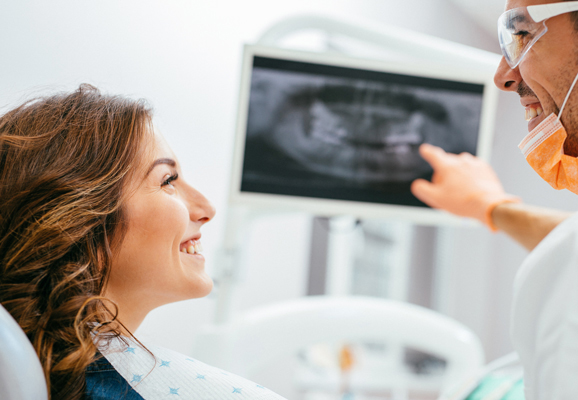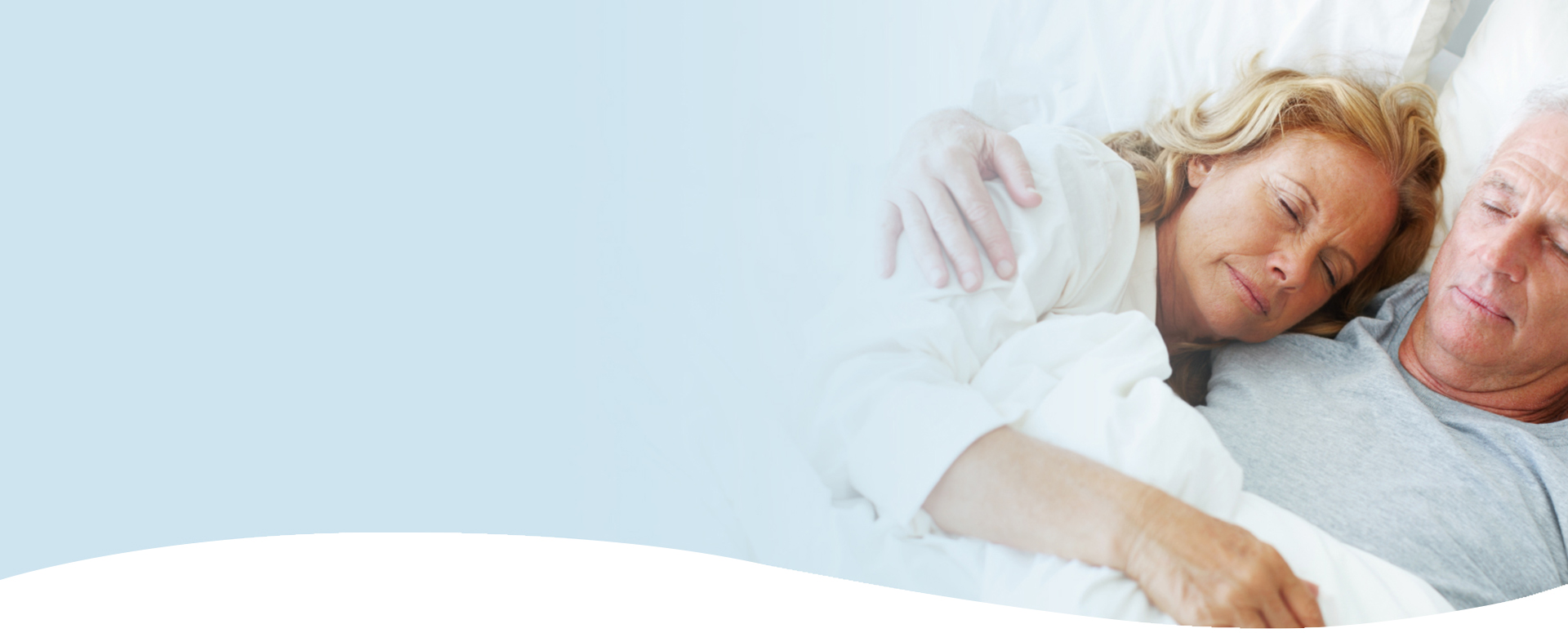
Sleep Apnea
Everyone has the occasional bad night of sleep. However, for millions of Americans, every night is a bad night of sleep. No matter what you do, you wake up morning after morning feeling completely exhausted, like you never went to sleep in the first place. This is a condition known as sleep apnea. With diagnosis and proper treatment, your sleep quality, and quality of life can be restored.
Sleep apnea is a condition that affects how you breathe when sleeping.
Breathing interrupted
No breath for 10 seconds or more
Exhaustion affects physical health
Wakeup without knowledge
Can happen hundreds of times a night
Disrupts sleep cycles
If sleep apnea is left untreated, it prevents you from getting enough deep, restorative sleep. Without enough deep sleep you may be sleepy, lack mental sharpness and be less productive.
Long term health effects can be serious, including:
Weight gain
High blood pressure
Heart disease
Diabetes
Sleep Apnea Types
Obstructive Sleep Apnea
Obstructive sleep apnea, commonly abbreviated as OSA, is the most common type of sleep apnea. This particular sleep apnea is caused by a partial or full blockage of your airway. When your airway is blocked by these tissues, it can interfere with your breathing.
OSA can be caused by
- Obesity
- Enlarged tonsils or adenoids
- Misalignment of your jaw
- Lifestyle habits such as smoking or excessive alcohol consumption
Central Sleep Apnea
Central sleep apnea, or CSA, is a type of sleep apnea that is much less common than OSA. It occurs when your brain temporarily fails to signal to the muscles that control your breathing that you need to breathe. Because your brain temporarily does not signal your breathing muscles, your breathing pauses. This particular type of sleep apnea is often the result of certain types of medical issues or issues that impact your brainstem.
Causes of central sleep apnea include
- Brain infections
- Stroke
- Heart failure
- Parkinson’s disease
- Obesity
Complex Sleep Apnea Syndrome
Complex sleep apnea syndrome, also referred to as mixed sleep apnea, is a type of sleep apnea that is a mix of both obstructive and central sleep apnea.
Causes and Symptoms of Sleep Apnea
Sleep Apnea Causes
As discussed, there are three different types of sleep apnea, obstructive sleep apnea, central sleep apnea, and mixed sleep apnea.
Obstructive sleep apnea is the most common type of sleep apnea. This particular type of sleep apnea occurs when your airway becomes blocked, either by your tongue or other intraoral tissues. When your airway is blocked by these tissues, it can interfere with your breathing.
Sleep Apnea Symptoms
- Loud, chronic snoring
- Insomnia
- Breathing pauses for long periods
- Waking up often at night
- Forgetfulness, irritability, depression
What are the risk factors for Sleep Apnea?
There are some different factors that can increase your risk of developing sleep apnea. Common risk factors include
- Being overweight or obese.
- A large neck circumference.
- Hypothyroidism.
- Your age. Older adults are more likely to develop sleep apnea.
- Being a male. Men are at a greater risk than women.
- Certain lifestyle habits such as smoking or excessive alcohol consumption.
- Your lower jaw is small.
How can I prevent Sleep Apnea?
You can lower your risk for, or even prevent, sleep apnea in a few different ways.
- Maintain a healthy weight.
- Avoid tobacco products and alcohol.
- Avoid sleeping on your back.
- Undergo orthodontic treatments to correct alignment issues.
- Invest in an oral appliance. This is a device that can be worn while you sleep to hold your jaw in proper alignment.
Sleep Apnea Diagnosis and Treatment
Sleep Apnea Diagnosis
Diagnosing sleep apnea is typically done through a sleep study, which is performed in a sleep clinic. During your sleep study, which is called a polysomnogram, you are attached to machines that monitor and record different information while you sleep. Your heart rate, breathing, brain activities, blood oxygen levels, and the movements of your arms and legs are all monitored. After your sleep study is complete, the next day, the recorded information is read by a sleep specialist, who can interpret the results and diagnose sleep apnea or other sleep-related issues and prescribe you with appropriate treatment.
Sleep Apnea Treatment
There are a number of different treatments that may be recommended for sleep apnea.
Specialist
Talk to a doctor trained in sleep apnea. Come visit our doctors today to start the process.
Oxygen Aid
Use supplemental oxygen while sleeping. This will help treat the symptoms, but it may not address any underlying issues
C-PAP Machine
A C-PAP (Continuous Positive Airflow Pressure) machine is a machine that delivers a constant flow of air through a small mask that is worn over your nose. This helps to keep your airway open while you sleep.
Oral Appliance
This treatment involves the use of a custom fit guard similar to a mouthguard that is worn while you sleep. These oral appliances, made by Dr. Mugford’s office, help your airway to stay open by keeping your lower jaw forward and preventing soft tissues from falling into your airway.
Oral Surgery
In some cases, surgery may be required. There are a few different types of procedures that may be performed, including removing excess oral tissue or moving your lower jaw forward.
Sleep Studies at a Clinic
Accurate diagnosis is necessary to enable effective treatment for sleep disorders. At The Mugford Center, our doctors may feel that a sleep study is a valuable diagnostic tool. The sleep study provides valuable insight into the causes of a person’s symptoms including which, if any, sleep disorder is present. Sleep studies are also used in people diagnosed with sleep disorders to monitor their response to treatment.
The Doctors would request a polysomnography, where you would be assessed overnight with painless sensors that record information. Our team would contact you after the sleep study to discuss the findings and whether your results indicate that you have a sleep disorder.
Diagnose Sleep Apnea at Home
It can be possible in some situations to diagnose sleep apnea at home. We evaluate your symptoms, which can be done with the help of your partner. We can also provide you with a simplified version of a sleep study that can be done in the comfort of your own home. The technology used measures your information while you sleep, such as your breathing, airflow, heart rate, and blood oxygen levels. Home sleep studies cannot always detect sleep apnea. Depending on your symptoms, you may still be recommended for a sleep study in a clinic.
Treating Sleep Apnea with a Home Remedy
Depending on your situation, and the severity of your sleep apnea, it may be possible to treat sleep apnea with a home remedy. For some, losing weight is all that is needed to eliminate sleep apnea. Exercise, particularly yoga, can help to improve blood oxygen levels. For congestion-related sleep apnea, a humidifier in your bedroom may help. Some individuals may be able to eliminate sleep apnea simply by quitting tobacco products or drinking alcohol.
There are a few things that you can do to help alleviate the symptoms of sleep apnea until the condition is treated.
Healthy Choices
Changing lifestyle habits, such as quitting smoking or adding exercise to your routine can be helpful.
Exercise & Weight
Exercise can also help you to lose and maintain a healthy weight.
Sleeping Position
Changing the position in which you sleep can also help. If you find that you continue to roll onto your back, a special pillow can aid in keeping you on your side.
Nasal Passage
Open your nasal passage via breathing strips, saline nasal flush, or a nasal dilator.
Head Position
Elevate your head using extra pillows or a body wedge.
Diet & Alcohol
Some people may have issues sleeping when they consume alcohol. Try eliminating alcoholic drinks from your diet to see if this helps.
Treating Sleep Apnea with an Oral Appliance Therapy
An oral appliance can often be an effective way to treat sleep apnea and more comfortable than a CPAP device. Most patients simply can’t stand the uncomfortable equipment and loud noises that comes along with the CPAP, resulting in non-compliance and worsening symptoms. At The Mugford Center, we offer a better solution: oral appliance therapy called the Metz appliance. These custom-made, safe, FDA-approved devices are designed to reposition the jaw and/or tongue just enough to prevent dangerous airway blockage, resulting in easy, uninterrupted breathing throughout the night. They’re unobtrusive, easy to wear, and even convenient to travel with!
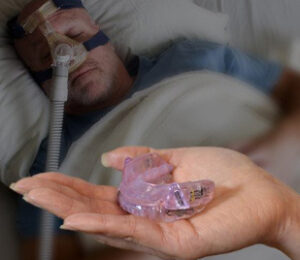
Oral appliance therapy might be a good option for you if:
- You are suffering from mild to moderate obstructive sleep apnea (OSA).
- You have had surgery to treat your sleep apnea and it did not achieve the desired result.
- You require sleep apnea treatment but are CPAP intolerant.
- You snore and are at risk of developing sleep apnea in the future.
- You travel often and need a sleep apnea treatment that is portable.
- You could benefit from combined therapy.
Oral appliance therapy utilizes the same basic principle as CPR: if the airway is blocked, a simple way to clear it is to shift the jaw forward. This is actually what our oral appliances do. This small movement prevents the soft tissues in the mouth and throat from relaxing into the airway, allowing a patient to breathe normally while they sleep. Other types of oral appliances also keep the tongue in a neutral position as well.
Schedule Your Sleep Apnea Consultation Today
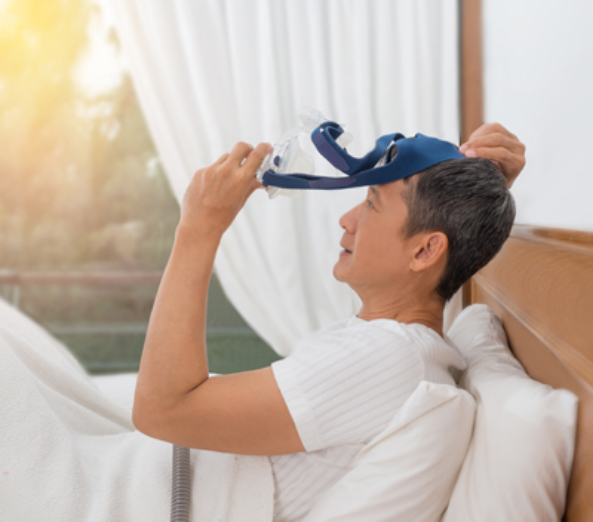
TMJ Treatments
When you suffer from temporomandibular joint problems, you may be in a great deal of pain. TMJ is a condition that deteriorates the joints that control your mouth. According to the American Dental Association, this often occurs after years of teeth grinding and clenching, bite problems, jaw injuries, or arthritis. Classic symptoms include headaches, neck pain, and clicking sounds when you chew. At The Mugford Center, our doctors may use various treatment plans for TMJ cases.
Sleep Apnea and TMJ Technology
Using advanced leading-edge technology, our doctors can see your facial anatomy in three dimensions and diagnose your unique situation.
Our iCat Cone Beam CAT Scan is a state-of-the-art piece of dental technology that helps us access TMJ and upper airway issues. The scan helps us view nasal septum, nasal airway, sinuses, oral airway, cervical spine position, and TMJ position. With this information, we’re able to access and understand the anatomical relationships in the neck and head area resulting in an accurate and timely diagnosis to use in planning your treatment.
Occlusal Adjustments
Occlusal (Bite) Adjustment is a procedure in which our doctors remove interferences from your teeth, thus treating misaligned teeth, a bad bite, crooked teeth, malocclusion, and other dental problems. You may need bite adjustment if your teeth don’t close properly because it can lead to several other complications, such as TMD or bruxism.
At The Mugford Center, we look for signs of misaligned teeth and crooked teeth during regular dental checkups. If you have misaligned teeth, our doctors will recommend the ideal occlusal adjustment procedure for your needs.
Misaligned Teeth
Importance of Occlusal Adjustment Equilibration
- Remove Interferences: There may be interference in your mouth due to dental works like crowns, bridges, and fillings. The occlusal adjustment removes these interferences to ensure a healthy bite.
- Dental Fractures: If you have a bad bite, you also have an uneven distribution of bite force. As such, when you bite down or close your teeth, some of your teeth sustain more impact than others. Over time, this can weaken some of your teeth, leading to the wearing away of enamel and dental fractures and cracks. You need bite alignment to minimize the risk of dental fractures.
- Restorative Dentistry: Your dentist will recommend bite alignment before you opt for certain prosthetic or restorative dentistry procedures, such as dental crowns and dental bridges.
- Prevent Malocclusion: If you don’t treat a bad bite, you may eventually suffer from malocclusion — misalignment of teeth and jaws. Over time, malocclusion leads to severe complications, including constant headaches, persistent bruxism, insomnia, fractured teeth, and temporomandibular joint disorder (TMD).
- Orthodontics: You may need occlusal adjustment before you opt for cosmetic orthodontic procedures, such as braces or Invisalign aligners.
Causes of Bad Bite and Misalignment
- Losing baby teeth too early.
- Harmful childhood oral habits, such as thumb-sucking.
- Prolonged bottle-feeding or use of pacifiers.
- Poor tongue and swallowing habits.
- Mouth breathing.
- Sustained orthodontic issues during childhood and adolescence.
Occlusal Bite Adjustment Diagnosis
Our team will look for signs of misaligned teeth and malocclusion during regular dental checkups. You may be asked to bite down on a piece of paper to examine your bite’s alignment. The following signs indicate that you may need occlusal bite adjustment:
- Your jaws don’t close properly on one side of your face.
- Your jaw makes popping or clicking sounds when you open or close them.
- Signs of dental fractures that get worse over time.
- Signs of premature wearing away of enamel.
Persistent teeth grinding and clenching (bruxism).
Occlusal Bite Alignment Procedure
- Our Doctors will ask you to close your teeth and bite down on a piece of double-sided articulating paper. This will allow Dr. Mugford or Dr. Bruce to see which side of your teeth are making contact. A healthy bite is one in which both make equal contact together. As such, if only one side is making contact, it’s an indication that its depth is different from the other side.
- Next, your Doctor uses a fine diamond or carbide burs to shave off some of the dental structure from the side of the teeth making contact. This is done to ensure both sides have the same length of crowns.
- In a healthy bite, the anterior teeth should make limited contact, compared to the posterior teeth.
- After reshaping your teeth, you will bite down on the articulating paper again.
Bite or Occlusal Guards
If TMJ is caused by grinding, you may be fit with a mouth guard that is to be worn overnight. The mouth guard helps protect your teeth from being worn down or chipped. Prevention is very important. In addition, reducing grinding forces is especially important for those with periodontal (gum) disease or those with dental implants.
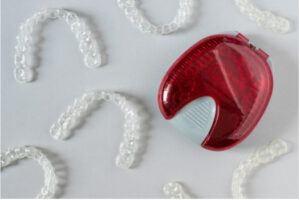
Beyond protecting your teeth, a bite guard reduces or relieves the pain and tension in your jaw muscles. This is achieved by helping to raise the bite and reposition the jaw to a position that helps relieve any symptoms and discomfort.
As a result, having this cushion between your teeth can:
- Relieve the strain and stress in your jaw muscles
- Reduce jaw pain, tightness, and soreness
- Reduce earaches, headaches, and facial pain
The Occlusal Guard will be constructed with specific and individualized properties to treat your symptoms. It is worn either on the top or bottom teeth and is made of a hybrid acrylic material that is softer on the inside and harder on the outside.
What is an occlusal guard?
Occlusal guards help protect your teeth from wearing down, especially the contact (chewing) surfaces. Which means that it can only do its job while you are wearing it.
Occlusal guards are also called night guards and are made from a thin but strong material in order to cushion the teeth from tooth-to-tooth contact if you unconsciously grind your teeth and clench your jaw.
With the help of a night guard (that you wear while you sleep), the force and pressure are absorbed to break up any grinding and clenching you might unconsciously do. These guards simply help protect your teeth from the damage caused by bruxism and are custom-tailored to your mouth to maximize your comfort while wearing it.
Unfortunately, unconscious nighttime teeth grinding exerts a stronger jaw force than clenching in the daytime where you may notice and control it. Without a night guard, your bruxing could leave you with:
- Broken teeth
- A leveling or flattening of the teeth
- Pain in the jaw, face, and head
- Sensitive teeth
- Gum recession
As you can imagine, this damage to your teeth and gums can be costly to fix, which costs you in additional pain, money, and time — which is why you should not wait to seek treatment.
While our experienced dentists, Dr. Mugford and Dr. Bruce, offer excellent restorative treatments, including dental implants, we prefer preventative solutions to stop tooth and gum issues from the get-go. Also, keeping your own natural teeth is ideal when it comes to your smile, so we’re actively on the side of taking preventative measures rather than repairing damage after the fact.
Occlusal guards can be worn in the day but are mostly worn at night to protect your teeth, keeping them from breaking under the unfettered force of the clenching jaw muscles. And while that is great news, the jaw muscles are still actively grinding, which means the jaw, head, neck and shoulders can still leave you hurting.
So in short: an occlusal guard can help prevent further damage from being done to your teeth, but it will not stop you from grinding or clenching your teeth.
To learn more about our occlusal treatments, give us a call to schedule an appointment at (410) 721-7801.

